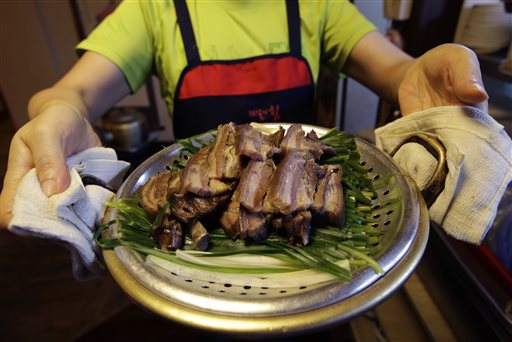
SEOUL, South Korea — For more than 30 years, chef and restaurant owner Oh Keum-il built her expertise in cooking one traditional South Korean delicacy: dog meat.
In her twenties, Oh traveled around South Korea to learn dog meat recipes from each region. During a period of South Korean reconciliation with North Korea early last decade, she went to Pyongyang as part of a business delegation and tasted a dozen different dog dishes, from dog stew to dog taffy, all served lavishly at the Koryo, one of the North’s best hotels.
She adapted famous dishes to include dog meat, replacing beef with dog in South Korea’s signature meat and rice dish bibimbap. But the 58-year-old’s lifelong experience with a food eaten for centuries in Korea is about to become history.

Daegyo, the famous dog meat restaurant she opened in a Seoul alley in 1981, will serve its last bowl of boshintang, or dog stew, on Friday, a reflection of the challenges facing a trade that is neither legal nor explicitly banned under South Korean laws governing livestock and food processing.
Opposite views on dogs as either for eating or petting have co-existed in the country’s recent history, feeding a controversy that becomes most bitter in the summer. On three “dog days,” which are among the hottest times of the year, many South Koreans queue for the dish of shredded dog meat and vegetables in hot red soup, believing it gives strength to bear the heat.
Animal rights activists protest nearby, urging people not to eat man’s best friend. The closure of Oh’s restaurant, dubbed by a local newspaper as the “Holy Land of boshintang” and frequented by two former presidents, Lee Myung-bak and late Roh Moo-hyun, shows one view of dogs is gaining more traction among young South Koreans.
“There is too much generational gap in boshintang,” said Oh. “There are no young customers.”
Dogs are also food in countries such as China and Vietnam. The long tradition of eating the meat in South Korea is such that a respected 17th century book on Korean medicine extols its health benefits. But today it is an increasingly tough sell and a less attractive dining option for young South Koreans. Oh plans to reopen her restaurant as a Korean beef barbecue diner.
Animal rights groups have also highlighted that some of the 2 million or so dogs eaten in South Korea each year suffer painful and inhumane deaths.
Most young people eat chicken soup on a dog day and even those who eat dog tend to refrain from talking about it openly, according to Moon Jaesuk, a 32-year researcher who enjoyed eating dog meat before he moved to Seoul.
“There’s a burden in a group of 10 or 20 people to suggest eating dog, like making a sexual joke,” he said. “It’s not easy to talk about eating dog when there are a lot of people.”
Young South Koreans grow up watching TV shows about raising puppies and other pets, which sapped appetite for dog meat, said Oh.
Her restaurant used to sell as many as 700 bowls of dog stew a day in the 1980s. These days it is less than half that. Young people also enjoy a diverse dining culture unlike previous generations that came of age amid the poverty that followed the 1950-1953 Korean War.
Meanwhile, Nonghyup Economic Research Institute forecasts the pet business in South Korea to swell to 6 trillion won ($5.9 billion) by 2020, from 0.9 trillion won in 2012. It says one in five South Korean households have either a pet dog or cat.
Sometimes the differing perceptions of dogs become a source of family tension. Kim Dongyoung, 30, said she gets into fierce arguments with her grandfather over her lap dog.
“Whenever he saw my dog at home, he would say it’s the size of one bowl of hot soup,” Kim said. She recently pulled out of signing a lease for an apartment when she saw it was in the same building as a dog stew restaurant.
There is no official data on the dog meat industry, but people who raise dogs as livestock or supply dog meat to diners say its consumption is in decline.
Butcher Shin Jang-gun who supplies dog cuts to restaurants said the number of merchants in the dog meat trading business has shrunk to half of what it was. He keeps a list of between 700 and 800 restaurants in Seoul, some current and others potential clients, and believes there was once more than 1,500.

His father sold only dog meat for several decades. After Shin inherited the butcher shop in southern Seoul in 2002, he added goat meat to offset declining dog meat sales.
“Dog is not an industry with a long-term future,” Shin said. “New generations don’t eat a lot.”
Choi Young-im, secretary general of an association of dog farmers, said dog meat, which used to be most popular after beef, pork and chicken, has been overtaken by duck but will remain a fixture on menus.
Choi estimated between 2 million and 2.5 million dogs are consumed in South Korea each year.
With one fewer dog meat restaurant in downtown Seoul, Oh feels sad that young people are losing touch with the tradition.
“Even now when I see young people at my restaurant, I feel so happy,” she said.
RELATED STORY










































